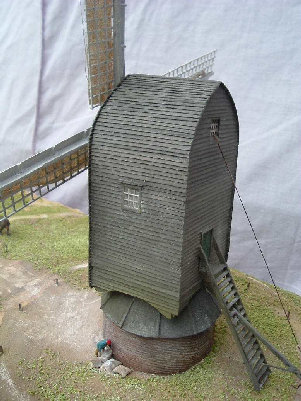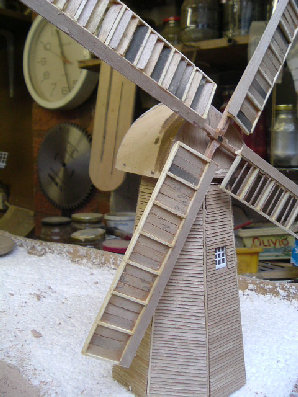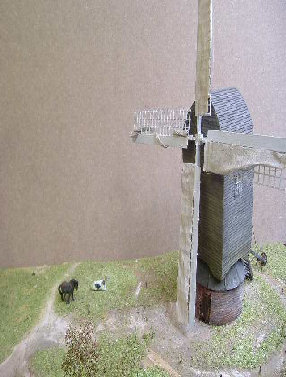


This phto shows the sails in various stages of setting or 'reefing '.
The mill would not be set to operate in such an unbalanced manner as shown but is displayed this way for the benefit of the museum visitors.
The wheel on the end of the tailpole can be seen here, the tailpole plays a major part in keeping the mill from toppling over
as it braces the structure gainst the wind.
Unlike permanent structures such as Tower mills it is possible to move a post mill to a new location should the need arise such as a change of land ownership.
Many mills such as this were left to slowly rot & decay after they were abandoned either because the miller could not afford expensive repairs or because modern milling machinery made his mill impracticable to run


POST MILL
The Post mill is one of the earliest designs and permits the mill to be turned into the wind by manually pushing the huge tailpole which projects from the back and so turning on the vertical post in the centre,the tailpole was often fitted
with an old cartwheel in later times to ease its movement if the miller was working alone.
In order to move the structure the heavy wooden stairs have to be lifted off the ground and a large pivoting lever is used to raise it a couple of inches clear of the ground.
Under the mill is a brick 'roundhouse' with a boarded and felted roof which serves as a storehouse although there is not a lot of space as the support braces for the huge 'post' take up most of the room
with an old cartwheel in later times to ease its movement if the miller was working alone.
In order to move the structure the heavy wooden stairs have to be lifted off the ground and a large pivoting lever is used to raise it a couple of inches clear of the ground.
Under the mill is a brick 'roundhouse' with a boarded and felted roof which serves as a storehouse although there is not a lot of space as the support braces for the huge 'post' take up most of the room
The mill shown here is also fitted with a small winch and circle of posts onto which a rope can be fitted so that the miller may have an alternative to pushing the tailpole if he is single handed. The mill is fitted with common sails - the very earliest and most basic form of sail .

1/96th Scale